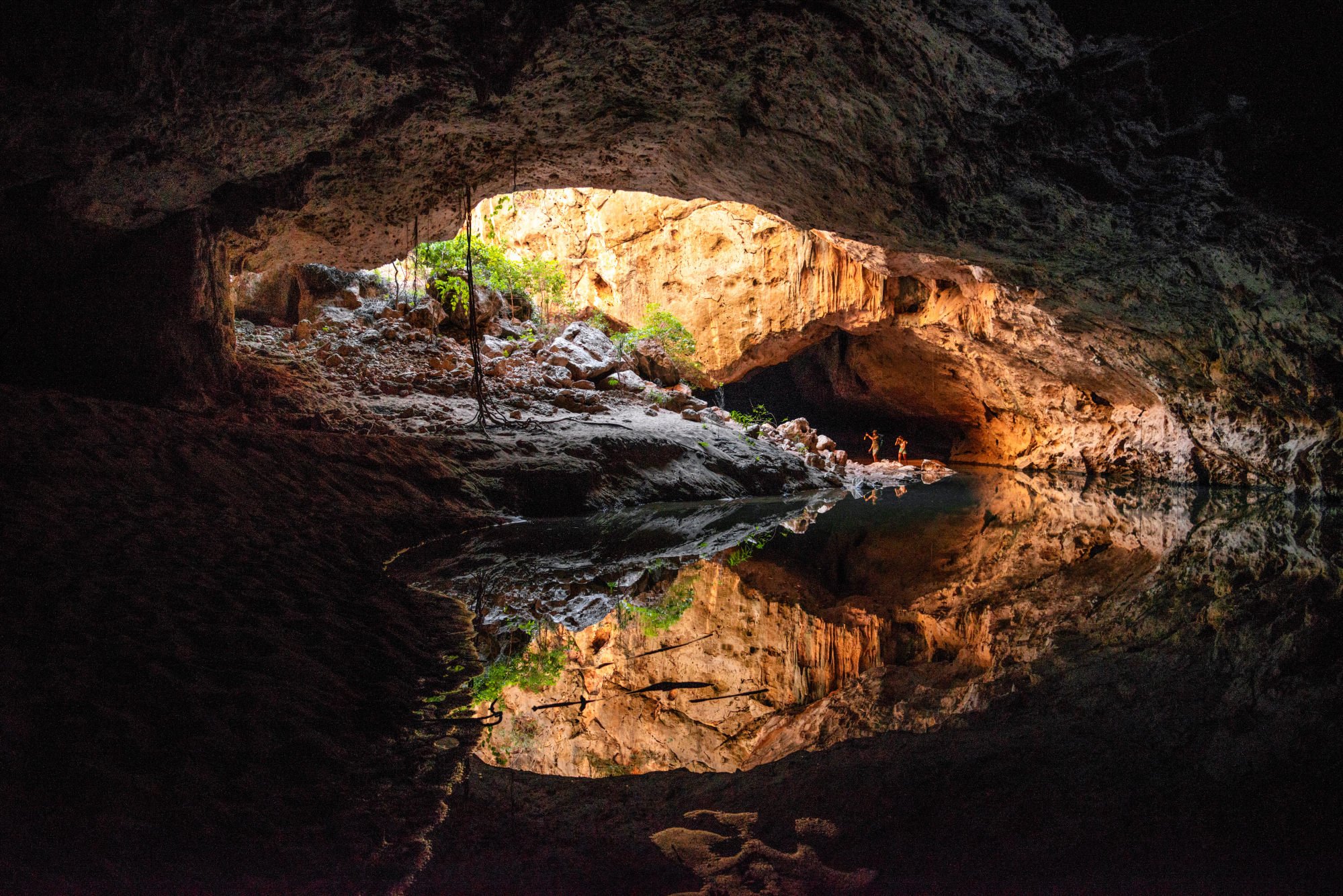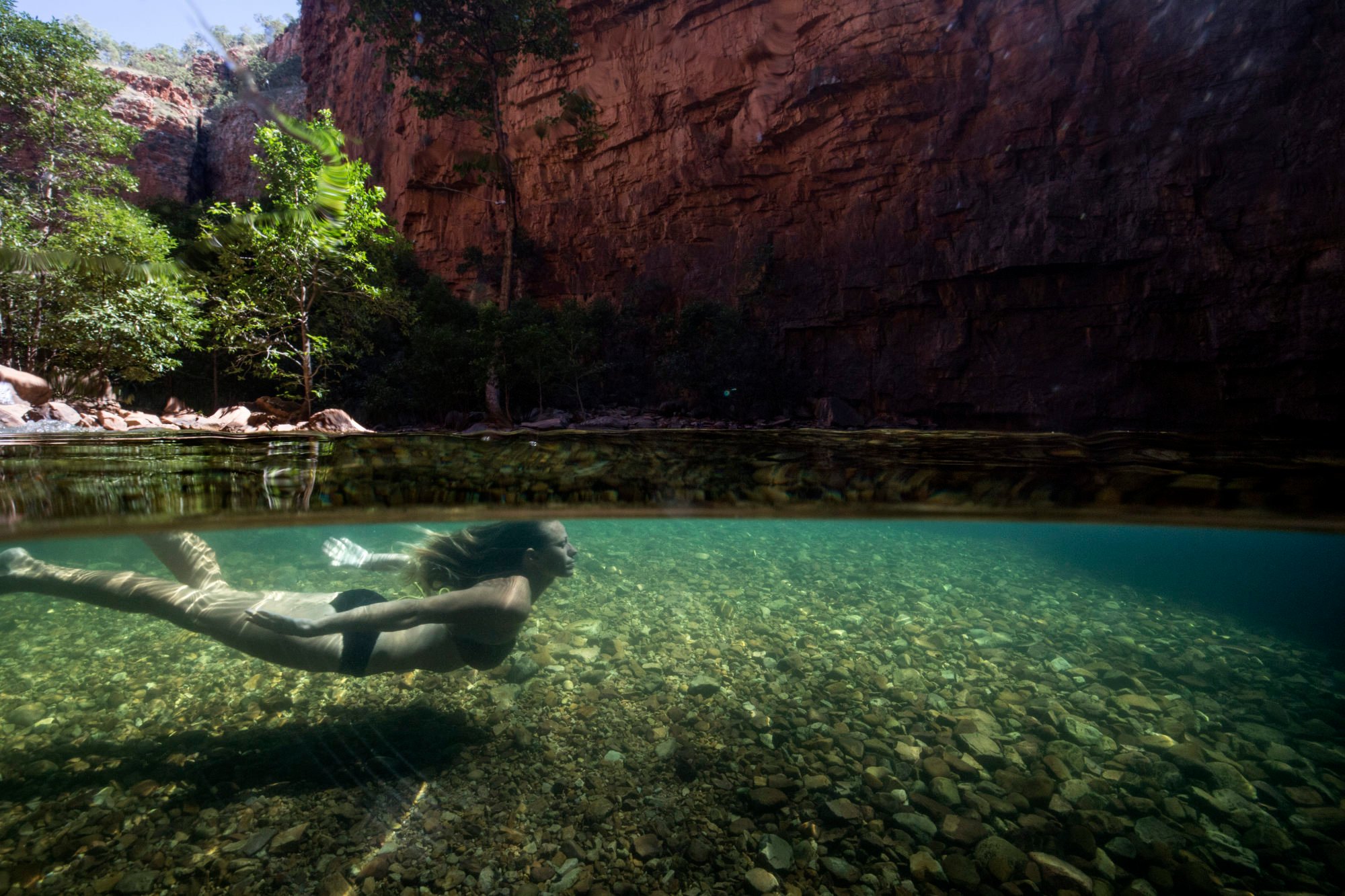
- A 4x4 trip through the wilderness of Australia’s northwest encompasses otherworldly scenery, Indigenous art, and animals seen nowhere else on Earth
It comes as a shock to discover that the floating log is actually alive. My heart skips a beat before I realise it’s a freshwater crocodile, or “freshie”.
These prehistoric reptiles are considered harmless unless harassed, but their bigger cousins, the saltwater crocodiles, demand a different level of respect.
At 423,000 sq km (163,000 square miles) – more than twice the size of China’s Guangdong province or nearly 385 times the size of Hong Kong – the Kimberley, the northwestern corner of Australia, is home to just 39,000 humans.
Visitors come to this part of Western Australia for the wilderness, pristine gorge swimming, connection to Indigenous cultures and, in our case, to tackle one of Australia’s greatest adventures: the Gibb River Road.

An unsealed four-wheel-drive road stretching for 660km (410 miles) between Derby (2,200km north of Perth) and Kununurra (830km southwest of Darwin), “the Gibb” is accessible only in the dry season, usually April to October. With three kids leaning into adulthood, the time for this bucket list trip is now.
To vastly reduce our driving time, we’ve started our trip in Broome, after a 2½-hour flight from Perth. We’ve hired a four-wheel-drive stocked with camping gear, solar panels and two rooftop tents that fold open in a minute.
It would be squashed with five people up there, so my 18-year-old has brought his own compact tent. After loading up with groceries, we roll out towards the Gibb.
Immediately the landscape turns to tufty spinifex grass, the white trunks of bloodwood trees and bulbous boab trees, with their branches zigzagging skywards. As phone range disappears we teach the kids how to track our progress on old-school paper maps.
In the late afternoon, we pull into our first camp, at Windjana Gorge, where our crocodile encounter takes place. Squawking cockatoos have settled down for the night when the blood-curdling scream of the bush stone curlew rings out, a ghostly love song.
Climbing the ladder into my cubby house tent I’m relishing this nature immersion. The next morning, we’re immersed in a more literal sense.

Signs at Tunnel Creek relate the history of the Indigenous Bunuba warrior Jandamarra (1873-1897), who led resistance against invading white pastoralists and hid in these caves for years.
With our head torches on, we slosh through the creek, which cuts through the ancient limestone reef.
We emerge at the far end to find Bunuba rock art on the walls.
Heading east, we arrive early at the popular swimming spot of Bell Gorge. Launching off rocks with big splashes, we explore downstream, swimming across chilly pools and scrambling over gurgling rapids, before stopping at a plummeting waterfall.

Sunning ourselves on the rocks, we spot a movement on the cliff face. A nimble, elusive black-flanked rock wallaby is sunning itself, too, beside its rocky cave.
For a three-day side adventure, we turn north onto the notoriously corrugated road to Mitchell Falls, stopping overnight at the Indigenous-owned Munurru campground, beside the King Edward River.
Two extensive rock art sites are found here, and we stroll the first alone, viewing images of willowy, humanlike figures in rapt silence.
This art style is called Gwion Gwion (also known as Bradshaw art, after the European who studied them) and may be up to 25,000 years old. The hundreds of paintings here include giant animals and mythical creatures.

At the second site we join a tour with Wunambal Gaambera Indigenous ranger Albert Bundamurra.
This site features the Wandjina art style and, as the afternoon sun slants across the golden savannah, Bundamurra leads the way through a maze of rocky tors, my kids hanging on his every word.
It’s easy to feel the spiritual significance. Bundamurra points out rock paintings of scaly tailed possums, which still live here, and Tasmanian tigers, which have been extinct across mainland Australia for more than 3,000 years.
Most haunting of all are the Wandjinas themselves, the wide-eyed, mouthless faces of the creation deities. Bundamurra views these as his ancestors and he must protect them.

For this reason, he prefers that, rather than explore on their own, visitors stick with a guide here, to appreciate the significance of what they are seeing.
“I worry about my Wandjinas,” Bundamurra says. “If [visitors] damage them, it’s going to ruin everything.”
Finally reaching the Mitchell Falls campsite, we start the 4.5km hike to the falls. Down a steep side track, we duck under a rocky tunnel, emerging in an amphitheatre behind the spray of Little Mertens waterfall, where there is more ancient rock art, including depictions of food items such as eels and freshwater crayfish.
Above the falls, we remove our shoes and wade across the river, and on to Mitchell Falls lookout, with its view of the 80-metre, four-tiered waterfall thundering through a series of pools and then blocky sandstone cliffs of orange and black.
On the return trek, it’s nearly dusk when my son spots Australia’s tiniest wallaby, the monjon. These critters with squirrel-like tails live only in this part of the Kimberley.
Back on the Gibb, we’re experimenting with free camping. Pulling off the road, we drive down a track beside the Durack River, passing a few caravaners before finding an idyllic spot all to ourselves.
In the morning, two sets of dingo tracks indicate we’ve been inspected and, as the sun rises, two enormous black-necked storks, like a pair of pterodactyls, soar majestically above the dry creek bed.
At the El Questro Wilderness Park, a former cattle station turned eco-tourism venture, we’ve booked early to secure a private campsite along the Pentecost River, which we share with a family of waddling quails.

Our site is 3km from the main accommodation hub, the Station, but we pop in for luxuries such as burgers, hot showers and laundry.
Campfires provide cheery warmth in the chilly evenings. After roasting marshmallows, we engage in hotly contested card games and I can’t remember when we laughed so much together before.
El Questro has dramatic scenery and many highlights. At Zebedee Springs we soak in the natural hot springs, and at Emma Gorge we float under the spectacular cliffs and droplet waterfall.
Our most adventurous hike is through El Questro Gorge, where the sunlight sparkles across walls of ferns. Balancing on wobbly river stones, wading across pools and scrambling up a waterfall adds to the attraction for the teenagers.

On a sunset cruise, as our boat chugs slowly between the ancient walls of the Chamberlain Gorge, we sip bubbly and spot birds of prey and rock wallabies. Our guide explains the natural and human history of the station and, at the turnaround point, archerfish shoot streams of water at us, demanding food.
Another morning, we’re up before dawn to join a birdwatching tour in an open safari vehicle, but the most spectacular birds we spot are wandering through our camp. Three elegant brolgas, standing almost as tall as us, stroll through the grassy woodland.
From El Questro, it’s just 45 minutes on a bitumen road into Kununurra, the hub of the east Kimberley.
Replenishing our food supplies, we head out to man-made Lake Argyle with its 98-metre-high dam on the Ord River. Atop the towering cliffs above the reservoir we camp at Lake Argyle Resort, where the highlight is the five-star views from the infinity pool.

South along the sealed Great Northern Highway is the Indigenous community of Warmun. A professional and well-resourced art centre is at the heart of this village and the artists themselves are painting canvases seated on the grass outside, creating modern paintings using traditional ochres.
Soon, one of these ultimate souvenirs is being packaged before being posted to our home.
Nearby, we turn into Purnululu National Park, home to the Unesco World Heritage-listed Bungle Bungle Range, a series of beehive-shaped domes. This otherworldly landscape has been a special place for the Gija and Jaru Indigenous people for millennia.
While local pastoralists had known about it for decades, the outside world was not aware of its existence until documentary makers stumbled upon it in 1982.

Hiking through this alien landscape, we visit quiet Whip Snake Gorge and popular Cathedral Gorge, where the kids experiment with the acoustics, their voices wrapping around circular caverns that have been carved out by wet-season deluges over 360 million years.
Further north in the national park, Echidna Chasm has sheer walls 180 metres high. We stretch our arms to touch both sides, and at midday, the sunshine turns the clifftops a vibrant gold.
Nearby, at Mini Palms Gorge, shade-stunted livistona palms grow on the canyon floor. The only visitors, we savour the silence.

Cranking up the noise and the adrenaline, we’re splurging on one final adventure. Given how bizarre and mysterious this landscape is, and realising we’ve only seen a fraction of the park, we figure seeing it from above will be enthralling.
After a safety briefing, we follow our HeliSpirit pilot out to the unsealed Bellburn Airstrip, in the southern part of the park, and strap in to an open-sided helicopter. Rising in a cloud of dust, we see the Bungles reveal their ethereal splendour, with hidden gorges, cliff-clinging palm trees and dry, snaking rivers that fade into desert.
Stealing a glance at the kids is equally enthralling; headsets on, hair whipping, grins broad. This Kimberley adventure has them engaging with the world, and they’re looking up, looking outwards.

